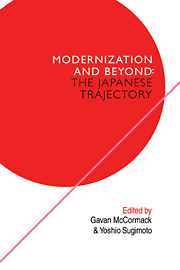Book contents
- Frontmatter
- Contents
- Contributors
- Introduction: modernization and beyond
- I Popular culture: tradition and ‘modernization’
- II Popular movements: alternative visions of ‘modernization’
- III Uneven development and its discontents
- IV Sex, politics and ‘modernity’
- 9 The Japanese women's movement: the counter-values to industrialism
- 10 Male homosexuality as treated by Japanese women writers
- 11 Body politics: abortion law reform
- 12 Division of labour: multinational sex in Asia
- V ‘Modernization’ and ‘modernity’: theoretical perspectives
- Glossary
- Index
11 - Body politics: abortion law reform
Published online by Cambridge University Press: 04 August 2010
- Frontmatter
- Contents
- Contributors
- Introduction: modernization and beyond
- I Popular culture: tradition and ‘modernization’
- II Popular movements: alternative visions of ‘modernization’
- III Uneven development and its discontents
- IV Sex, politics and ‘modernity’
- 9 The Japanese women's movement: the counter-values to industrialism
- 10 Male homosexuality as treated by Japanese women writers
- 11 Body politics: abortion law reform
- 12 Division of labour: multinational sex in Asia
- V ‘Modernization’ and ‘modernity’: theoretical perspectives
- Glossary
- Index
Summary
In 1985 a letter campaign was launched by sectors of the Japanese women's movement against the Asahi newspaper, following an article published by that paper on 22nd April. The article described the contents of an American film entitled ‘The Silent Scream’, which had already caused considerable controversy in the United States. It is a twenty-eight minute film narrated by Dr. Bernard Nathanson and sponsored by anti-abortion campaign funds. Nathanson, himself an ex-abortionist, subsequently declared himself ‘pro-life’.
The controversy surrounding the film relates to one particular scene in which the film shows the abortion of a twelve-week foetus. Nathanson's narration describes the child moving serenely in the uterus … The child senses aggression in its sanctuary … We see the child's mouth wide open in a silent scream. The Asahi article describes in considerable detail the content of this anti-abortion film. Despite its own admission that both medical and cinema experts have questioned the credibility of both the scene and Nathanson's reading of it, the article concluded that: ‘The practically indisputable fact that we learn from this film is that abortion is an extremely violent act of cruelly killing a small and helpless life.’
The Japanese women's movement reacted angrily to the Asahi's condoning of a film which had been publicly accused of using sophisticated editing techniques to create false evidence for the anti-abortion case. ‘The Silent Scream’ was one element of a concerted anti-abortion campaign mounted in 1985.
- Type
- Chapter
- Information
- The Japanese TrajectoryModernization and Beyond, pp. 205 - 217Publisher: Cambridge University PressPrint publication year: 1988
- 1
- Cited by



